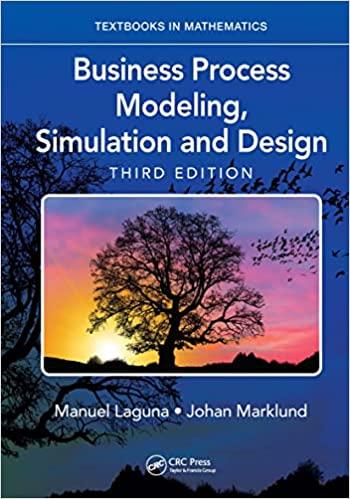Answered step by step
Verified Expert Solution
Question
1 Approved Answer
please do all question ( 8 parts) each account as well. thankyou Requirement-1: Journalize the following transactions. Note: You do not need to consider any


please do all question ( 8 parts) each account as well. thankyou
Requirement-1: Journalize the following transactions. Note: You do not need to consider any account for Interest payable and wages payable, as those are being paid on schedule. Jan 1, 2019: Owners invested $120,000 in the business account. Jan 1: They purchased an active restaurant for $250,000; paid $50,000 down payment and the rest on a 10-year loan (N/P). They were scheduled for monthly payments of $3,500 from which $2,000 goes against the principal of the loan and $1,500 as interest. Payments are due end of each month. To make it easy, let assume that from $250,000 of the purchase cost, $150,000 is considered as equipment and $100,000 as furniture. Jan 2: They paid $3,000 for the rent of Jan. Jan 2: They prepaid $4,800 for one year insurance. Jan 2: They purchased $40,000 equipment, $10,000 in cash and the rest on account (A/P). Jan 3: They purchased $20,000 of inventory in cash. Jan 3: They purchased $ 2,000 supplies in cash. Jan 8: They had total sales of $25,000 during the first week. 80% of the sales was in cash and 20% on credit card (CC/R). Those sales cost them using $5,000 of the inventory. Jan 10: They paid $2,000 of the A/P. Jan 12: They purchased $4,000 inventory on account (A/P). Jan 15: They had $30,000 sales in the second week; 70% in cash, 10% on customers account (A/R), and 20% on credit card (CC/R). Those sales cost them using $6,000 of the inventory. Jan 15: They paid $10,000 for employees' wages. Jan 16: They received $3,000 from credit card companies (regarding the CC/R). Jan 23: They had $30,000 sales; 80% in cash, 10% on customers account (A/R), and 10% on credit card (CC/R). Those sales cost them using $6,000 of the inventory. Jan 24: They paid $4,000 of the A/P. Jan 25: They purchased $6,000 inventory on account. Jan 29: They paid $7,000 wages. Jan 29: They received $2,000 from customers who were billed before. Jan 29: They received $4,000 from credit card companies. Jan 29: They had $25,000 sales: 70% in cash, 10% on customers account (A/R), and 20% on credit card (CC/R). Those sales cost them using $5,000 of the inventory. Jan 29: They paid $3,500 for their loan (N/P). Remember only $2,000 of payments goes against the principal of the loan. Feb 1: They paid $3,000 for rent Feb 2. Distributed $30,000 dividends to the owners. Feb 3: They received $2,000 from credit card companies. Feb 3: They purchased $25,000 inventory: $2,000 in cash and the rest on account Feb 7: They had $20,000 sales; 70% in cash, 10% on customers account (A/R), and 20% on credit card (CC/R). Those sales cost them using $4,000 of the inventory. Feb 8: They received a utility bill of $500 which was due in three weeks. (U/P). Feb 9: They received $3,000 from the customers who were billed before. Feb 10: They paid $3,000 for A/P. Feb 14: They had $15,000 sales; 60% in cash, 20% on customers account (A/R), and 20% on credit card (CC/R). Those sales cost them using $3,000 of the inventory. Feb 14: They paid $6,000 for wages. Feb 15: Owners invested additional $50,000 in the business. Feb 16: They purchased $3,000 inventory in cash. Feb 23: They had sales of $20,000; $12,000 in cash and the rest on customers' account. Those sales cost them using $4,000 of the inventory Feb 24: They paid $500 for the utility bill dated Feb 8. Feb 25: They paid $2,000 for A/P. Feb 29: They had $30,000 sales; 70% in cash, 10% on customers account (A/R), and 20% on credit card (CC/R). Those sales cost them using $6,000 of the inventory. Feb 29: Distributed $20,000 dividends to owners. Feb 29: They paid $3,500 for their loan (N/P). Remember only $2,000 of payments goes against the principal of the loan. Feb 29: They purchased $2,000 supplies on account Requirement-2: Post from journal to T-Accounts (make the T-accounts in scrap paper and do not submit them with your work) Requirement-3: Prepare a trial balance for the end of Feb. Requirement-4: Journalize the adjustments for the following cases: a. Two months of the insurance has expired. b. Only $500 of supplies are left. C. Equipment in the restaurant depreciated $500 per month. Furniture in restaurant depreciated $300 per month. Requirement-S: Update those accounts that have been adjusted. Requirement-6: Prepare an adjusted trial balance. Requirement-7: Prepare Income Statement, RE Statement, and Balance Sheet Requirement-8: Journalize the closing of temporary accounts based on the recent adjusted trial balance. Then prepare a post-closing trial balance. Note: You may need to use the following accounts: Cash, Common Stocks, A/P, A/R, CC/R. N/P, U/P, ACC.DEP Equipment, ACC-DEP Furniture, Inventory, Supplies, PP-Insurance, Dividends, Re, and the following expenses: Rent Exp. Supply Exp, Insurance Exp, Interest-Exp, Wages Exp, CGS, Utility Exp, Dep-Exp Equipment, Dep-Exp Furniture. Feel free to add any account, if needed. Please consider 15% tax in your income statementStep by Step Solution
There are 3 Steps involved in it
Step: 1

Get Instant Access to Expert-Tailored Solutions
See step-by-step solutions with expert insights and AI powered tools for academic success
Step: 2

Step: 3

Ace Your Homework with AI
Get the answers you need in no time with our AI-driven, step-by-step assistance
Get Started


